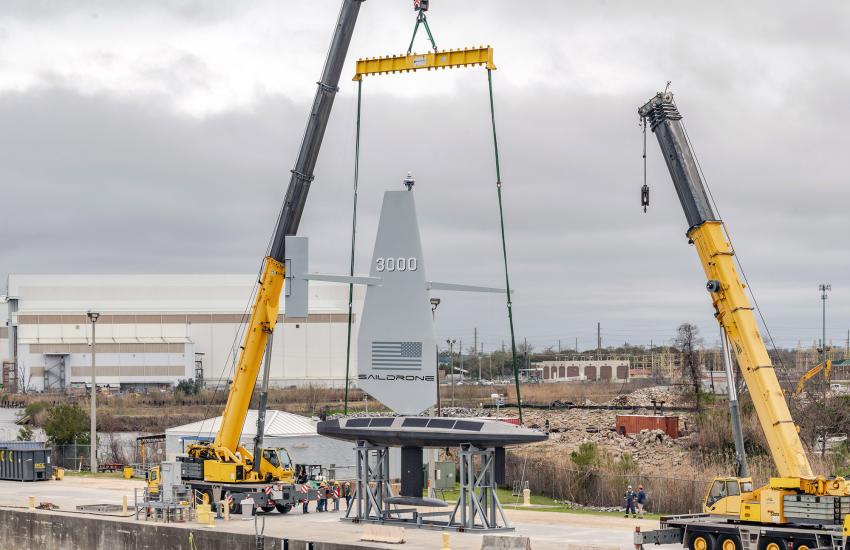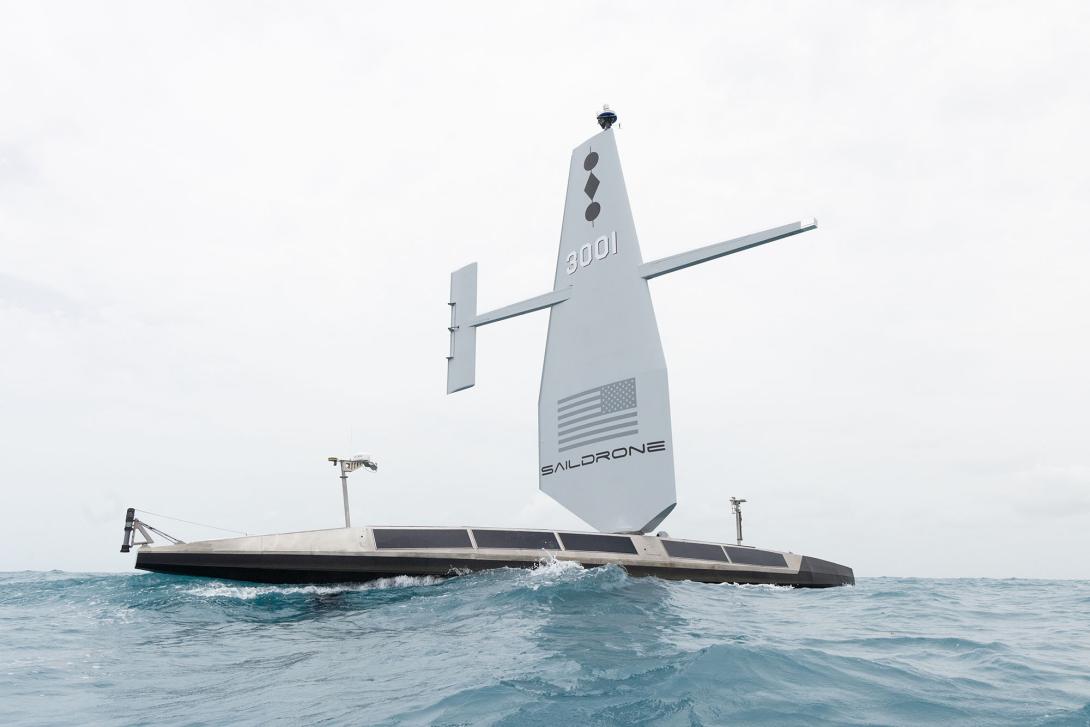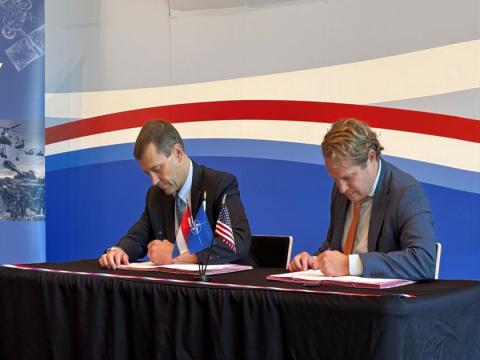U.S. Navy Saildrones On
To bolster its growing hybrid fleet, the U.S. Navy is looking to leverage innovative solutions for a more secure and robust environment. One such solution is the use of unmanned surface vehicles, also known as USVs, to deliver situational awareness for those on land and at sea.
At a February hearing in front of the U.S. Senate Committee on Armed Services, Adm. Alvin Holsey, USN, commander for U.S. Southern Command, spoke on the matter.
“Over the last couple years, we’ve seen a decrement in Navy assets in the region,” he said in response to Sen. Tommy Tuberville’s (R-Ala.) question about the technology and its use in the Indo-Pacific and Caribbean regions.
“One thing that Navy has done with this new hybrid fleet out of [U.S. Naval Forces Southern Command (NAVSOUTH)], we’ve been able to incorporate saildrones into our mission sets. They provide great domain awareness,” Holsey stated.
Holsey was referring to saildrones built and provided by the U.S.-based company, Saildrone, founded in 2012 and later contracted for use by the U.S. Navy.
“Right now, we’re doing Operation Southern Sphere, where at this point, we’ll have saildrones in the Caribbean and in the Eastern Pacific, along with other unmanned assets to counter the drug fight,” Holsey continued.
“One thing our partners continue to ask for is domain awareness, intel sharing. So again, having those assets in the region for a lack of other assets is making a difference for me.”
Launched in January, Operation Southern Spear is an initiative to advance the Navy’s hybrid fleet campaign. According to a NAVSOUTH spokesperson, the operation’s focus is on integrating unmanned systems with U.S. Coast Guard cutters “at sea and operations centers at Fourth Fleet and Joint Interagency Task Force South.”
Results from Southern Spear will help inform collaboration among regional partners and allies. The initiative is also an effort to establish the region as a theater for innovation, the spokesperson added.
Saildrone founder and CEO Richard Jenkins, who set a world speed record for his wind-powered vehicle in 2009, has long been a believer in autonomous systems becoming the future, and his innovation was going to help facilitate that, he told SIGNAL Media in an interview.
“I tried to sell something back then and this was before autonomy was even a thing, and the Navy sort of laughed and said we have these great big things with guns, how can we possibly use small autonomous systems?” he recalled from conversations that took place around 2014, shortly after Saildrone was founded.
The company then proceeded to work with other organizations such as the National Oceanic and Atmospheric Administration and NASA to collect meteorological and oceanographic data, which looks at weather forecasting and sea variables.
“We really toughened the vehicles in a commercial sense, and they sent us to parts of the world they couldn’t afford to send the ships, so the Arctic, the Antarctic, hurricanes, we did thousands of iterations on the vehicles to really toughen the hardware,” Jenkins explained.
A later partnership with other customers like the U.S. Coast Guard helped increase the sophistication of sensors onboard, such as cameras, radars, radio frequency detection, acoustics and more, to begin the collection of data.
Half the value of Saildrone is in its data, Jenkins stated. With 250 people at the company, half of the entire staff are software engineers, he said. The data, therefore, becomes the product.
For operations like Southern Spear, or for other customers such as U.S. Customs and Border Protection, this kind of data is key in decision-making. In cases of identifying drug smugglers, the data collected from the tens of thousands of ships and boats detected by Saildrone’s capabilities helps identify who needs to be interdicted.
“We used machine learning and AI [artificial intelligence] that give patterns of life activity to really give the customer pieces of insight into what they want to know,” Jenkins said.
With 20 platforms currently operating around the clock globally, 10 are in the Caribbean region and 10 are in the Eastern Pacific region.

Depending on the size of the vehicle, the maximum amount of time it takes to build varies between one to six weeks. Additionally, the average deployment is around 100 days per vehicle. The drones can also go as far as 2,000 miles away from shore.
“All 20 of those drones are performing the same mission, which is providing real-time intelligence ... directly to the operation center,” said William Byrne, director of strategy for defense at Saildrone. Byrne joined the company in June 2024 after more than seven years serving in the U.S. Navy.
“We are basically the eyes and ears of the fleet as they look to interdict those types of nefarious activity,” he told SIGNAL Media.
While Saildrone’s vehicles are fully autonomous, they still require some level of oversight to help get to their destination. “Our folks at Saildrone are working shoulder-to-shoulder with the folks at NAVSOUTH, the Navy, the Coast Guard; they’re taking the intent of the location of where they’d like those drones to operate and then our folks are doing the heavy labor side of that, which is pushing the drones to where they need to be, and then the drone itself using some advanced AI/ML algorithms on the boat, taking that data ... ingesting it aboard the system and deciding what is relevant and what is not,” Byrne explained.
“Once that processing has happened, that data is piped off the drone and lands back to the operator. Basically, we’re making sense out of immense amounts of data, so the operator at the end state is only seeing what is relevant.”
All AI/ML capabilities used have been designed in-house, Jenkins added, also noting the company’s use of localized manufacturing.
With his prior experience, Byrne says the progression of unmanned systems is significant for the Navy. “When you look at the challenges that the United States faces globally ... one of them is mass, so you need numbers in order to address all of those problems,” he said. “Numbers don’t come easy when you’re talking about the maritime environment. It’s very difficult to field ships; they take years, or even unmanned systems, to test them to make sure they’re robust.” Another challenge is capability testing to ensure its relevance and success.
As the fleet grows, innovation like this is a vital resource, he said.
And while the Eastern Pacific and Caribbean regions are strategically important, Jenkins also noted future plans for operations in the Western Pacific and Arctic regions.
“A Pacific fight will be thousands of nautical miles from the nearest U.S. shoreline,” Byrne added. “I think it’s really important that we learn the right lessons,” he said, referencing the war in Ukraine. “One of the things that will be important in the Pacific that might not be as relevant in Ukraine is that distance, so it’s the ability to persist for not days or even a week, but months at a time, because we’re dealing with a much larger and more contested environment.”




Comments